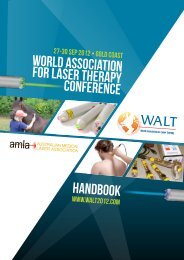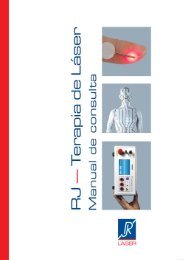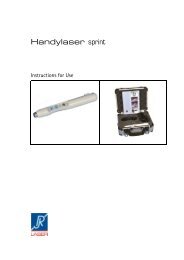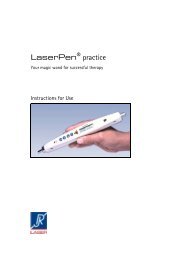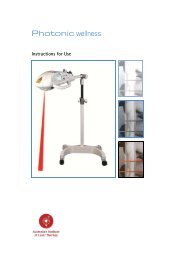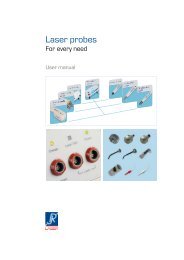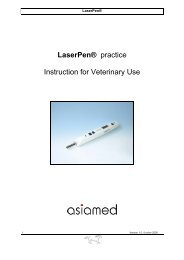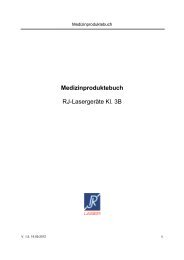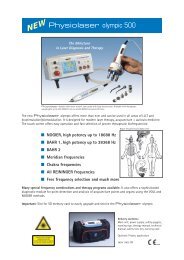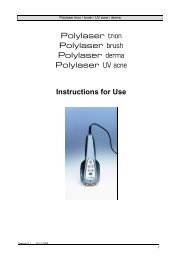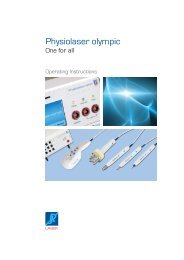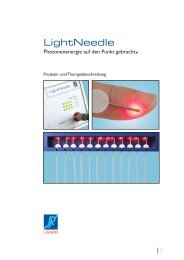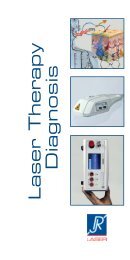LightNeedle - RJ Laser
LightNeedle - RJ Laser
LightNeedle - RJ Laser
You also want an ePaper? Increase the reach of your titles
YUMPU automatically turns print PDFs into web optimized ePapers that Google loves.
Abstracts <strong>Laser</strong> Acupuncture<br />
<strong>Laser</strong>-Needle Therapy for Spontaneous Osteonecrosis of the Knee<br />
Winfried Banzer, M.D., Ph.D.,1 Markus Hübscher, Ph.D.,1 and Detlef Schikora, Ph.D.2<br />
Objective: This case report describes the treatment of a 63-year-old patient with spontaneous<br />
osteonecrosis of the knee (SONK). Background Data: SONK usually appears in the elderly patient<br />
without the typical risk factors for osteonecrosis. It is characterized by acute and sudden pain,<br />
mostly occurring at the medial side of the knee joint. Symptoms usually worsen with physical<br />
activity and improve with rest. Besides physical therapy, limited weight-bearing and the use of<br />
analgesics and nonsteroidal anti-inflammatory drugs, we propose lowlevel laser therapy (LLLT)<br />
as a conservative treatment option.<br />
Methods: LLLT was carried out using laser needles emitting radiation with wavelengths of 685<br />
and 885 nm, and a power density of 17.8 W/cm2. Therapy sessions lasted 60 min and were<br />
performed daily over a period of 3 mo. The total irradiation dose emitted by 8 laser needles in 60<br />
min of treatment was 1008 J.<br />
Results: Magnetic resonance imaging revealed distinct restitution<br />
of the spongiosa edema 5 wk after treatment onset, and the final check-up at 35 wk demonstrated<br />
complete restoration of integrity.<br />
Conclusion: The present case report provides the first indication that laser-needle therapy may<br />
be a promising tool for complementary and alternative therapeutic intervention for those with<br />
SONK.<br />
Quantification of Gender Specific Thermal Sensory<br />
and Pain Threshold Before and After <strong>Laser</strong>needle Stimulation<br />
1Abteilung für Biomedizintechnische Forschung in Anästhesie und Intensivmedizin,<br />
Medizinische Universität Graz, Österreich<br />
2Fachbereich Physik – Optoelektronik, Universität Paderborn, Deutschland<br />
3Klinische Abteilung für Neuro- und Gesichtschirurgische Anästhesiologie und Intensivmedizin,<br />
Medizinische Universität Graz, Österreich<br />
Quantitative thermal sensory and pain threshold testing (QST) was performed in 29 adult<br />
healthy volunteers (mean age 24.2 ± 2.7 years; range: 18–29 years; 20 females, 9 males) using<br />
the Thermal Sensory Analyser TSA-II (Medoc Advanced Medical Systems, Ramat Yishai,<br />
Israel, and Minneapolis, Minnesota, USA) before and after laser needle acupuncture and placebo<br />
stimulation, respectively.<br />
Significant (p 0,001; t-test) gender-specific differences were seen on cold pain threshold<br />
analysis. No significant changes in parameters of thermal sensory and pain thresholds were<br />
found before and after laser needle or placebo stimulation at acupuncture points for acute pain.<br />
However, a trend towards change in the median value of cold pain sensation after laser needle<br />
stimulation (p = 0.479; paired t-test; n.s.) was seen within the group of healthy females.<br />
The influence of stimulation of acupuncture points for chronic pain on the various parameters<br />
needs to be clarified in future studies.<br />
Please contact <strong>RJ</strong>-LASER in order to get the complete paper:<br />
contact@rj-laser.com<br />
15



